When he found the bodies, George Bascom was furious. Didn’t this prove what he had been saying all along, that the Indian chief and his followers were ruthless killers? They had undoubtedly slain the little boy too, which was why they had been refusing to return him.
The four bodies were riddled with lance punctures. They showed signs of having been tortured. Bascom buried them under the old oak trees. It never occurred to him that he was the one responsible for their deaths.
Bascom, a US Army lieutenant, new to the region, possessed that ill-fated combination of arrogance and fear that is often precursor to disaster. His cocksure certainty that Cochise and his band of wild Apaches were responsible for the kidnapping of a rancher’s son would set in motion a series of events that would ignite a 25 year war of terror in the American Southwest.
The Other Side of the Story
The truth was Cochise had nothing to do with the kidnapping. The Apache Indian chief had been trying for some time to convince the lieutenant of that, even suggesting that he might know the band responsible and offering to negotiate with them on the army’s behalf. But Bascom wasn’t buying it. As far as he was concerned, Cochise had taken the boy and that was the end of it.
So Bascom arranged to meet Cochise at Apache Pass. Cochise brought his family along, his wife, brother and nephews, as a sign of his submissiveness, but he did not bring the boy. Angered, Bascom had the chief placed under arrest.
But his captivity didn’t last long. Cochise cut his way out of the tent and fled into the countryside. Bascom immediately seized Cochise’s family and sent word that they would be held hostage until the Apache chief returned the kidnapped boy.
Cochise had a reputation among his people for honesty and fair-dealing, but he had his limits. Bascom had not only injured him, he had insulted him, so Cochise ordered the kidnapping of four white settlers to use as bargaining chips to secure the release of his family. But when he offered them to Bascom, Bascom stubbornly refused to release his family in exchange. Angry, frustrated, at his wit’s ends, Cochise killed the settlers, and now Bascom stood over their bodies, vowing vengeance. Things were about to get ugly.
Snakes in the Grass
150 years later, I stood on the spot where the Bascom Affair had taken place. It had taken some doing to get here. Although the area had once straddled a wagon road in the 19th century, these days it was far out in a stretch of uninhabited desert, thirteen miles south of I-10 near the end of a mile long hike at the Fort Bowie National Historic Site in southeastern Arizona.
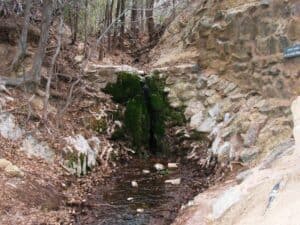
Apache Springs still exists, trickling down a shelf of rock into a shallow pool at the end of a dry wash.
It was late in the day, and I was the only one here. The air was perfectly still. Occasionally there was a stirring amidst the ocotillo. Rattlesnakes? I continued walking.
This place had been important to the Apaches because it was near a spring. The spring still exists, trickling its precious water down a shelf of rock into a shallow pool at the end of a dry wash. I stood before it, absorbing the importance of this modest resource in the midst of a dry and waterless desert.
When hostilities broke out with the Apaches in 1862, the US Army sent troops here to secure the spring. It was Apache land. After a pitched battle, costing hundreds of lives, the army drove the Apaches off and built a fort to secure the area.
The ruins of Fort Bowie sit on the top of a wind blown prominence. The decaying adobe walls and tumbled down remains surround a parade ground that hasn’t seen a military boot in more than a century.
Yet when the army drove the Apaches off their land, the Apaches did something unexpected. Unlike other Native-American tribes who quickly succumbed to Whites’ demands to surrender, the Apaches withdrew into the surrounding countryside and kept on fighting, prosecuting a guerilla war against the US army and the local white civilian population that struck terror into the hearts of all.
Monumental Stupidity

Bush’s ill-timed “mission accomplished” declaration was prefigured in American history by the US army’s apparently easy defeat of the Apaches.
Because the Apaches were easily driven off at first, the army was tempted – as George W. Bush had been more than a century later – to declare mission accomplished. But they soon discovered, as did the Bush administration, that their declaration of victory was premature, and, worse yet, that their mismanagement of the affair had only succeeded in creating an entrenched insurgency.
Whether or not today’s military industrial complex intends to mire us in long, unwinnable wars, this has certainly been our fate since 1945. To believe this is calculated, however, makes the mistake of giving too much credit to those who are responsible. Sure, they may be devious and cunning, but we must also consider the possibility that they are incompetent.
For years I have marveled at the monumental stupidity it took to get us into another prolonged foreign war against an indigenous insurgency, one that quickly devolved into a civil war, forcing us to take sides, dragging on year after year, costing us blood and treasure. Had we learned nothing from Vietnam?
The answer, of course, is no. Our leaders had learned nothing. They had never cracked a book on Vietnam that was not written to support a viewpoint they already had. They were willfully ignorant about something that had caused our country great trauma within their own lifetimes, so how could they possibly possess any awareness about another historical event, one with even greater parallels to the fiasco they were embarking on?
Striking Parallels
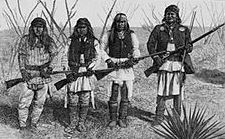
The Apaches, a bitter and determined foe who had learned enough of our technology to turn it against us.
The Apache Wars were America’s first experience with protracted guerilla warfare. Like our recent conflicts in Iraq and Afghanistan, they were fought in forbidding desert territory that was native to the enemy, and, at first, dangerously unfamiliar to our military.They were fought against a bitter and determined foe who viewed us as occupiers and who had adopted enough of our technology to turn it against us.
And like our misadventures in Afghanistan, they were fought near a border region, allowing the terrorists to strike and then melt away into a neighboring country. That country, like its modern day equivalent, was an unreliable ally whose cooperation was tenuous.
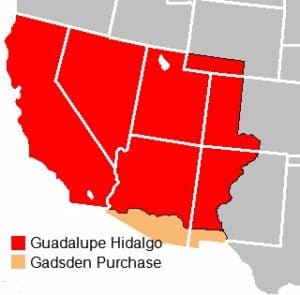
Territory acquired from Mexico in the Treaty of Guadalupe Hidalgo, which ended the Mexican-American War, and in the subsequent Gadsen Purchase.
Only thirteen years prior to the Bascom Affair, the United States had been at war with Mexico. Mexico’s defeat resulted in our annexation of a large swath of territory, home to several present day states including California, Arizona and New Mexico. In acquiring the former Mexican territory, however, we inherited several Mexican problems, among them, the Apaches.
The Mexicans had been at war with the Apaches for nearly a quarter of a century. The Apaches were a violent and warlike people that ranged over a large territory embracing the northern Mexican states of Sonora and Chihuahua, as well as large portions of present day Texas, New Mexico, and Arizona.
The Apaches were raiders and earned their living by striking neighboring tribes, wrecking havoc, and making off with cattle and foodstores. They had lived this way for more than a century when the Spanish arrived and dispossessed the natives. It was an easy thing for the Apache to switch to raiding Spanish encampments. And when the Mexicans won their independence, the Apache were not discriminating in switching to Mexican settlements.
In yet another fascinating parallel to recent history, the United States made a brief alliance with the Apaches in an attempt to harass the Mexicans during the Mexican-American War. Like the iconic image of Donald Rumsfeld shaking hands with Sadaam Hussein during our brief alliance with the Iraqis against the Soviets, we made common cause with a future enemy, then succeeded in turning them against us.
Yet the notion that we could ever have lived peacefully with the Apaches was a stretch. In fact, the events that led to the rift were precipitated by typical Apache aggression, a raid on a settler’s ranch that resulted in the theft of his cattle and the kidnapping of his son. But the incident that turned the whole thing into a full scale war was strictly to the credit of the Americans.
The Bascom Affair was a blunder on the scale of the discovery of weapons of mass destruction in Iraq. Ignorant, incompetent people prosecuting their own agenda with a disdain for the facts and little thought for the long term consequences.
Terrorism in America
Full of righteous indignation, Bascom killed Cochise’s brother and nephews as payback for the killing of the settlers. Naturally, the Apaches went on the warpath. For the next twenty-five years war raged in the American Southwest. Full scale attacks on army troops were interspersed with fearsome raids on remote ranches and mining camps. Terror was the name of the game.

In a grim foreshadowing of Abu Ghraib, the US military committed outrages in the Southwest that only inflamed the violence.
Victims were hung by their heels over slow fires. They were buried up to their necks in the sand and left to be devoured by ants. They were staked out with wet thongs in the midday sun so that the thongs dried and tightened, pulling their bodies apart slowly. Women were raped. Infants were roasted on spits. Bodies were mutilated. Heads were cut off and mounted on pikes.
The United States military got into the act as well. They agreed to meet with noted Apache leader Mangas Colorades under a flag of truce, and then took him prisoner, tortured and killed him. As if that wasn’t enough, they cut off his head, boiled it, and sent it east to be displayed at the Smithsonian Institution. Naturally, this ill-advised and unnecessary provocation only added fuel to the fire, much in the way the mindless torture at Abu Ghraib inflamed the Iraqis.

With many troops withdrawn to fight the Civil War, the settlers were left to the tender mercies of the Apaches.
And Bascom’s provocation of the Apaches couldn’t have come at a worse time. It brought war to the region at precisely the moment when US troops were being withdrawn from the Southwest and redeployed to fight the Civil War.
The poor terrified settlers were left to their own devices. Not unlike the US experience in Iraq, the presumed beneficiaries of the military’s escapade came to resent their liberators for the havoc they’d foisted upon them.
60 Years of Hostility
After the Civil War the US government redoubled its effort to put down the Apaches, but with no more wisdom or discretion. A white led massacre of Apache women and children at Camp Grant near Tucson in 1871 triggered another convulsion of violence. In 1879 the Apaches attacked and massacred 49 setters at Alma, New Mexico. The US Army retaliated and fought several bloody battles against the Apaches, finally routing them in 1881 at the Battle of Carrizo Canyon.
But the Apaches weren’t finished yet. Behind their wily leader Geronimo, they struck again in the early 1880’s. Even after Geronimo was defeated, the Apaches carried on. US army troops won medals of honor for their struggles against the Apaches as late as the 1890’s. Hostile Apaches remained a threat to ranchers as late as the 1920’s. And the last Apache warriors weren’t flushed from the mountains of southeastern Arizona until the 1930’s.
In the end, like their fellow Native-Americans, they were pushed onto a reservation. Today, the San Carlos Reservation is home to 9,000 ancestors of the Apache warriors who fought so doggedly against the United States in the 19th century. Ironically, some of them actually fought for us in Iraq.
Those Who Fail to Learn the Lessons of History…
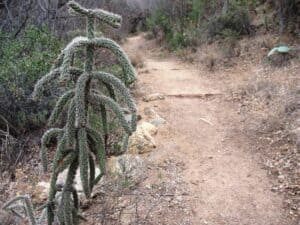
I didn’t stray from the path. There were rattlesnakes out there, and they knew the terrain better than I.
I hiked back from Fort Bowie in the middle of the desert as the sun went down. No one else was around. I stayed on the path. There were rattlesnakes around there. It was their territory.
But if it had been my job to remove them, the last thing I would’ve done is leave the path and start kicking through the brush. Instead, I would’ve gone home and read a book on the behavior of rattlesnakes. I would’ve learned what angers them, what soothes them, and I would’ve understood the terrain, about which they know so much, and I know so little.
Believe it or not, some day the ruins of American bases in the Middle East will deteriorate in the wind and sun.
Perhaps then a solitary traveler will walk among them, wondering at the upheaval and bloodshed, and, looking around at the vast stretches of desolation, wonder if there could have been another way.
But by then those responsible will be long gone, and like Lieutenant George Bascom before them, their arrogance will be overlooked or forgotten, leading a new generation of gung-ho leaders, disdainful of culture and history, and eager to prosecute their own agendas, to make the same mistakes all over again.
Check it out…
Fort Bowie National Historic Site
Previous stop on the odyssey: Taos, NM //
Next stop on the odyssey: Palm Springs, CA
| Sources:Ball, Eve. Indeh: An Apache Odyssey. Norman, OK. University of Oklahoma Press. 15 Sept 1988. Print.Carlin, Dan. Apache Tears. Hardcore History podcast. 14 March 2008.
|
| About the author: Malcolm Logan is a freelance writer who specializes in US travel and US history, designing driving tours, seeking out interesting destinations and exploring US adventure travel. He can be reached at myamericanodyssey1@gmail.com
|
| Image Credits: George Bascom, Public Domain; Apache Pass, Malcolm Logan; Cochise-Bascom Meeting Place, Public Domain; Apache Springs, Malcolm Logan; Ft. Bowie, Malcolm Logan; Bush declaring mission accomplished, Public Domain; Vietnam, Public Domain; Armed Apaches, Public Domain; Territory acquired from Mexico, Public Domain; Donald Rumsfeld and Sadaam Hussein, Public Domain; US army riding out of Ft. Bowie, Public Domain; Torture at Abu Ghraib, Public Domain; Indians preparing to attack, Public Domain; Cattle, Malcolm Logan; Cholla cactus at Ft. Bowie, Malcolm Logan; Sunset at Ft. Bowie, Malcolm Logan |

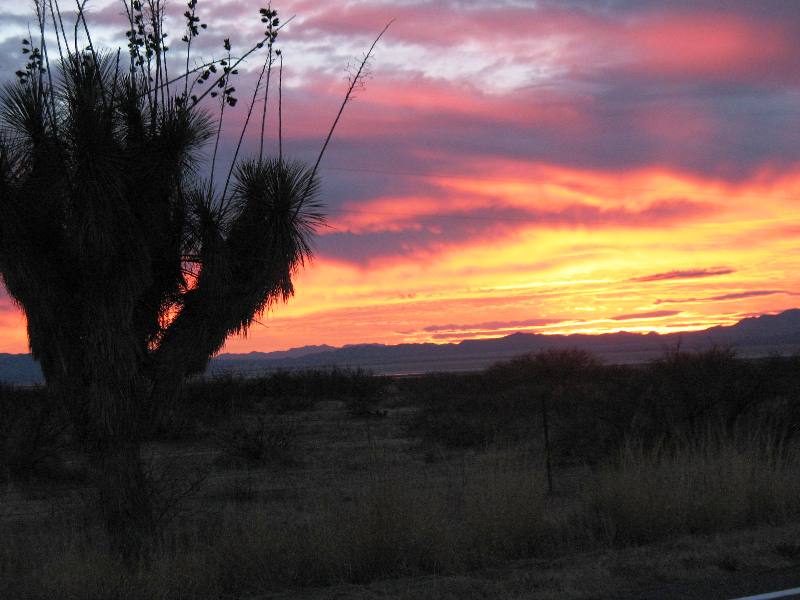
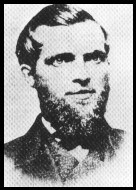
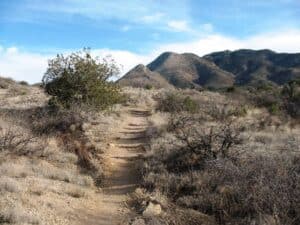
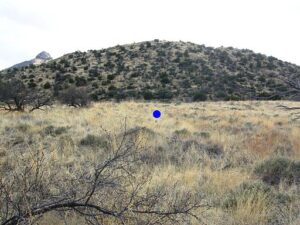
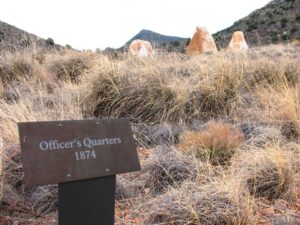



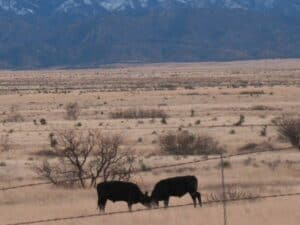
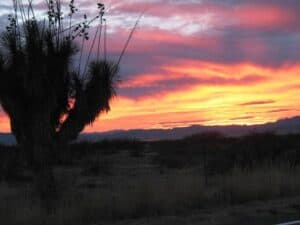
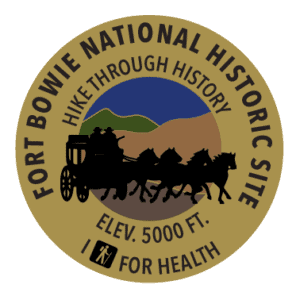
1 comment
[…] stop on the odyssey: Ft. Bowie, AZ // Next stop on the odyssey: Santa Barbara, […]